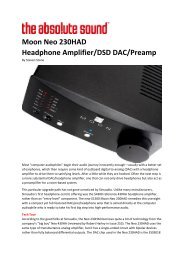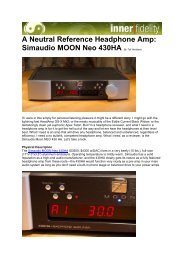Create successful ePaper yourself
Turn your PDF publications into a flip-book with our unique Google optimized e-Paper software.
SIMAUDIO MOON NEO 340i<br />
on the pedals.<br />
Vicissitudes of Power<br />
The aspect of recorded<br />
music that is most affected<br />
by preamplifiers<br />
and power amplifiers is<br />
its viscosity—ie, how thick<br />
or thin or transparent the<br />
music sounds. This in turn affects grain, contrast structure,<br />
and, especially, musical flow. The perceived viscosity or<br />
plasticity of an audio amplifier’s sound lies typically in its<br />
internal impedances, time constants, bandwidth, and voltage<br />
plus current capabilities. Musical viscosity also depends on<br />
the designer’s choice of resistors, capacitors, regulators, and<br />
transformers.<br />
I mention all this because it sounded to me that the<br />
Simaudio design team has made some sophisticated<br />
viscosity-oriented design choices that have resulted in audio<br />
products, like the Moon Neo 340i, of unique transparency<br />
and fluidity.<br />
Phono Stage: Moving-coil<br />
I change phono cartridges often. Therefore, I’m always<br />
happy when an integrated amplifier includes choices of gain<br />
The Neo 340i rear<br />
panel, with the<br />
optional phono and<br />
digital modules.<br />
(40 or 60dB) and loading (100 ohms or<br />
47k ohms plus 0pF or 100pF), as does<br />
the Moon Neo 340i D3PX. Simaudio<br />
uses active circuitry—as opposed to transformers—for<br />
the extra gain.<br />
Unlike most phono stages, in which choices of amplifier<br />
gain and cartridge loading are made with little switches<br />
or buttons, the Neo 340i’s phono stage requires that you<br />
(or your dealer) remove the amp’s top plate and reposition<br />
separate right- and left-channel jumper blocks for each<br />
choice. I know, it sounds tricky, maybe even dangerous—but<br />
it’s not. It’s simple, almost foolproof, and explained very<br />
clearly in the manual. The whole procedure took me less<br />
than 10 minutes, and its simplicity gave me the opportunity<br />
to experiment and be fickle.<br />
Most important, the results were worth the effort: The<br />
measurements, continued<br />
The output impedance at the lineoutput<br />
jacks was a low 100 ohms at<br />
all audio frequencies. Measured at the<br />
speaker outputs, it was a very low 0.05<br />
ohm at low and middle frequencies<br />
(including the series resistance of 10'<br />
of speaker cable), rising inconsequentially<br />
to 0.08 ohm at the top of the<br />
audioband. As a result, the modulation<br />
of the Neo 340i’s frequency response<br />
by the Ohm’s law interaction between<br />
this impedance and that of our standard<br />
simulated loudspeaker 1 was just<br />
±0.09dB (fig.8, gray trace). The output<br />
was down by 3dB at a high 90kHz,<br />
meaning that a 10kHz squarewave was<br />
reproduced with short risetimes (fig.9),<br />
and there was no overshoot or ringing.<br />
The 340i’s frequency response was<br />
the same at all volume-control settings<br />
and for both balanced and unbalanced<br />
inputs.<br />
Channel separation for the line-level<br />
inputs was an even 74dB R–L, but lower<br />
at high frequencies in the other direction.<br />
The unweighted, wideband S/N<br />
ratio, measured with the inputs shorted<br />
to ground but the volume control set to<br />
its maximum, was a modest 71.2dB ref.<br />
2.83V into 8 ohms, improving to 87.4dB<br />
when the measurement bandwidth<br />
was limited to the audioband, and to<br />
90.2dB when A-weighted. These figures<br />
were for the left channel; the right<br />
channel’s ratios were all 2–3dB smaller,<br />
due to there being a higher level of<br />
spuriae at 60Hz and its harmonics in<br />
that channel (fig.10). These ratios and<br />
graph were taken with an unbalanced<br />
input; with a balanced input, these<br />
spuriae were all up to 12dB higher in<br />
level, which I suspect is due to the fact<br />
that these inputs are carried on a small<br />
board connected to the main board<br />
with flying leads.<br />
The Neo 340i’s maximum power<br />
is specified as 100Wpc into 8 ohms<br />
(20dBW) or 200W into 4 ohms<br />
(17dBW). Figs. 11 and 12 reveal that,<br />
with both channels driven, the amplifier<br />
clipped at 130Wpc into 8 ohms<br />
(21.1dBW) and 200Wpc into 4 ohms,<br />
with low levels of distortion at output<br />
powers of a few tens of watts. To be<br />
sure I was looking at true distortion,<br />
I tested (fig.13) how the THD+noise<br />
percentage changed with frequency<br />
1 See www.stereophile.com/content/real-lifemeasurements-page-2.<br />
d<br />
B<br />
r<br />
A<br />
% %<br />
Fig.10 Simaudio Moon Neo 340i, unbalanced input,<br />
spectrum of 1kHz sinewave, DC–1kHz, at 1W into 8<br />
ohms (linear frequency scale).<br />
Hz<br />
Fig.11 Simaudio Moon Neo 340i, THD+N (%) vs<br />
1kHz continuous output power into 8 ohms.<br />
W<br />
Fig.12 Simaudio Moon Neo 340i, THD+N (%) vs<br />
1kHz continuous output power into 4 ohms.<br />
W<br />
stereophile.com Q March 2016 93





